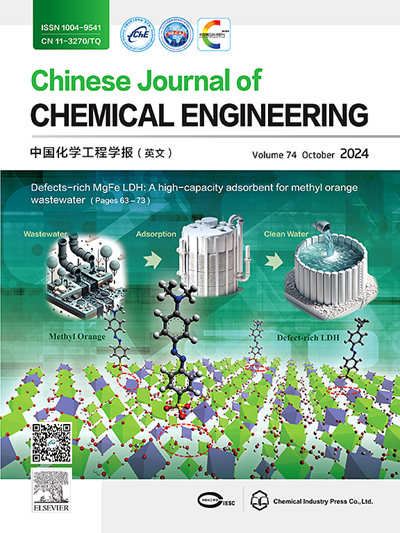锂电池生产中NMP废液的渗透蒸发-吸附耦合回收研究及技术经济性能评价
IF 3.7
3区 工程技术
Q2 ENGINEERING, CHEMICAL
引用次数: 0
摘要
n -甲基吡咯烷酮(NMP)是生产锂电池的重要溶剂,直接排放会造成环境污染和资源浪费。目前常用的真空蒸馏回收工艺存在运行成本高、能耗大的问题。因此,本文提出了一种耦合过蒸发-吸附(PV-A)工艺来回收锂电池生产废液中的NMP溶剂。在本工艺中,采用渗透蒸发对NMP废液进行脱水,发现在脱水400 min后,原液中的含水量从最初的8.3%(质量)下降到0.14%(质量),但当原液含水量下降到0.45%(质量)时,膜分离性能明显下降,同时NMP损失率迅速增加。采用吸附工艺去除剩余液中的微量水,在最佳吸附工艺条件下,进料液中的含水量从0.45%(质量)降低到0.014%,完全满足生产锂电池用电子级NMP的纯度要求。对所提出的耦合工艺进行了稳态建模和技术经济评价,并与真空蒸馏和渗透蒸发工艺进行了比较,结果表明,PV-A工艺的技术经济性能最佳,环境影响最小,可作为传统NMP回收工艺的替代工艺。本研究为锂电池工业中NMP的回收利用提供了一种新的方法。本文章由计算机程序翻译,如有差异,请以英文原文为准。

Study on the recovery of NMP waste liquid in lithium battery production by coupled pervaporation–adsorption process and evaluation of technical and economic performances
N-methyl-pyrrolidone (NMP) is an important solvent for the production of lithium batteries, which causes environmental pollution and wastes resources if it is directly discharged. The current commonly used vacuum distillation recovery process suffers from high operating costs and high energy consumption. Therefore, this paper proposes a coupled pervaporation-adsorption (PV-A) process to recover NMP solvents from lithium battery production waste streams. In this process, pervaporation is used to dewater the NMP waste liquid, it was found that the water content in the raw material liquid decreased from the initial 8.3% (mass) to 0.14% (mass) after 400 min of dewatering, but the membrane separation performance decreased significantly when the water content of the raw material liquid decreased to 0.45% (mass), and at the same time, the NMP loss rate increased rapidly. An adsorption process was used to remove trace water from the remaining liquid, and the water content in the feed liquid under the optimal adsorption process conditions was reduced from 0.45% (mass) to 0.014%, which fully meets the purity requirements of electronics-grade NMP for the production of lithium batteries. Steady-state modeling and techno-economic evaluation of the proposed coupled process were carried out, and compared with vacuum distillation and pervaporation technologies, the results showed the PV-A process yielded the best techno-economic performance and the lowest environmental impact, and it can be used as an alternative process to the traditional NMP recycling technology. This study provides a new method for the recycling of NMP in the lithium battery industry.
求助全文
通过发布文献求助,成功后即可免费获取论文全文。
去求助
来源期刊

Chinese Journal of Chemical Engineering
工程技术-工程:化工
CiteScore
6.60
自引率
5.30%
发文量
4309
审稿时长
31 days
期刊介绍:
The Chinese Journal of Chemical Engineering (Monthly, started in 1982) is the official journal of the Chemical Industry and Engineering Society of China and published by the Chemical Industry Press Co. Ltd. The aim of the journal is to develop the international exchange of scientific and technical information in the field of chemical engineering. It publishes original research papers that cover the major advancements and achievements in chemical engineering in China as well as some articles from overseas contributors.
The topics of journal include chemical engineering, chemical technology, biochemical engineering, energy and environmental engineering and other relevant fields. Papers are published on the basis of their relevance to theoretical research, practical application or potential uses in the industry as Research Papers, Communications, Reviews and Perspectives. Prominent domestic and overseas chemical experts and scholars have been invited to form an International Advisory Board and the Editorial Committee. It enjoys recognition among Chinese academia and industry as a reliable source of information of what is going on in chemical engineering research, both domestic and abroad.
 求助内容:
求助内容: 应助结果提醒方式:
应助结果提醒方式:


